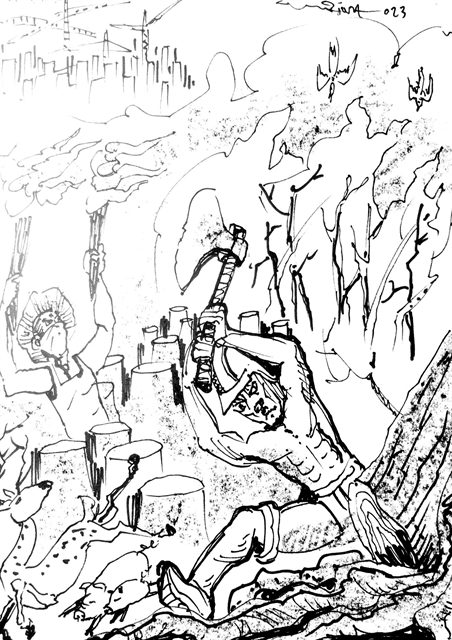The reservoir which is expected to provide water for 7,762 ha of agricultural land in South Hàm Thuận District will submerge a vast area of forests.

Illustration by Trịnh Lập
by Nguyễn Mỹ Hà
An uproar broke out this week after an article raised a question regarding 600ha of special-use forest, the same size as the West Lake in Hà Nội, which was to be submerged in a new reservoir to provide water for the drought-prone South Hàm Thuận District in Ninh Thuận Province.
The catchy headline grabbed the immediate attention of many netizens, who shared the story and called for an end to destroying forests.
In 2019, a project on the Ka Pét reservoir received the National Assembly's approval but was delayed due to the pandemic.
The reservoir will submerge a valley of forests, deemed poor forests because all aged-old and hardwood trees were cut down. The reservoir will provide water for 7,762 ha of agricultural land in South Hàm Thuận District.
It’s also expected to provide about 2,63 million cubic water to Hàm Kiệm II industrial zone as well as water for daily use of more than 120,000 people living in the city of Phan Thiết and South Hàm Thuận District.
The Bình Thuân’s leadership, who proposed the Ka Pét Reservoir project, laid out their goals and ambitions: the reservoir also has a goal to control floods for the lowland of South Hàm Thuận District and the 120,000 population of the city of Phan Thiết accordingly.
In Bình Thuận Province, South Hàm Thuận is located in an area that is most drought-prone in the country. In the rainy season, there is much flooding whereas in the dry season, the water current is very limited, not providing enough water for people in the area.
Environment studies estimated that the current lakes and reservoirs in the province provide only 26 per cent of water demand in the region, still lacking about 100 million cubic metres every year.
Pro-reservoir arguments are based on livelihoods and providing water resources for the country's driest area. They also have the support of Vũ Thanh Ca, Director of Việt Nam Institute for Seas and Islands, as well as Đào Nhật Đình, a prominent environment advocate and journalist.
Vũ Thanh Ca, a respectable advocate for the environment among the NGO groups, has written his own assessments on how the reservoir should be built to store water.
He believes that any solution should consider the wellbeing of people living in harmony with nature and the environment.
"Some people may suggest that Bình Thuận, as a dry province, needs to drop its agriculture and turn to industry and services. But I need to remind people that the sustainable pillars of development are: the economy, society and environment. Development will be in vain if it doesn't bring in value for the people. Development must help create work, generate income and bring a better life for people," Dr. Ca writes.
He writes that the development project must factor in the traditions of the land and its people, and continue the current strengths of Bình Thuận's already known agriculture goods and products, travel destinations and service, which have been its primary sources of income.
Even if Bình Thuận is geared towards high-tech agriculture practices in the future, it still needs a strong and secure source of water.
He cites statistics that show that the rain level during the rainy season, and the evaporation rates during the dry season do not match, which causes issues.
"It is worth noting that climate change shall feature higher temperatures and heat from the sun, which then drives the wind speed and dryness in the dry season. This means even drought shall be heightened and lack of water will get worse," Dr. Ca writes.
"To store water for the dry season, I believe that Ka Pét Reservoir with its channels shall provide enough water for the city of Phan Thiết and South Hàm Thuận District."
In his response to critics of his methods and arguments, Dr. Ca accepted that they were only estimates.
For the process of providing the Environment Assessment Report, only 15 days were given to collect public feedbacks and until now, the Ministry of Environment and Natural Resources reportedly has not received any documents from the Ka Pét Reservoir Project.
Article No. 33 of Environment Law states that any environment-related project has to provide Environment Assessment Studies to consider its impacts for later approval.
The Head of the Environment Department under the ministry, Nguyễn Hưng Thịnh said they had not received any documentation.
One thing can be agreed upon is that water means life. South Hàm Thuận District badly needs water for its residents and their cattle and farms. The issue rests on one question: how are we going to store the rain water during the rainy season for use in the dry season?
Putting aside any group interest that submerging the 600ha of forest could bring, they still have a sound argument: water is needed for people and farms and animals. Without water, no one can survive. VNS